09/19/18
K-State Current - September 19, 2018
K-State Current is a weekly news update for the Kansas Board of Regents to apprise the Regents on a few of the many successes and achievements made by K-State faculty, staff and students.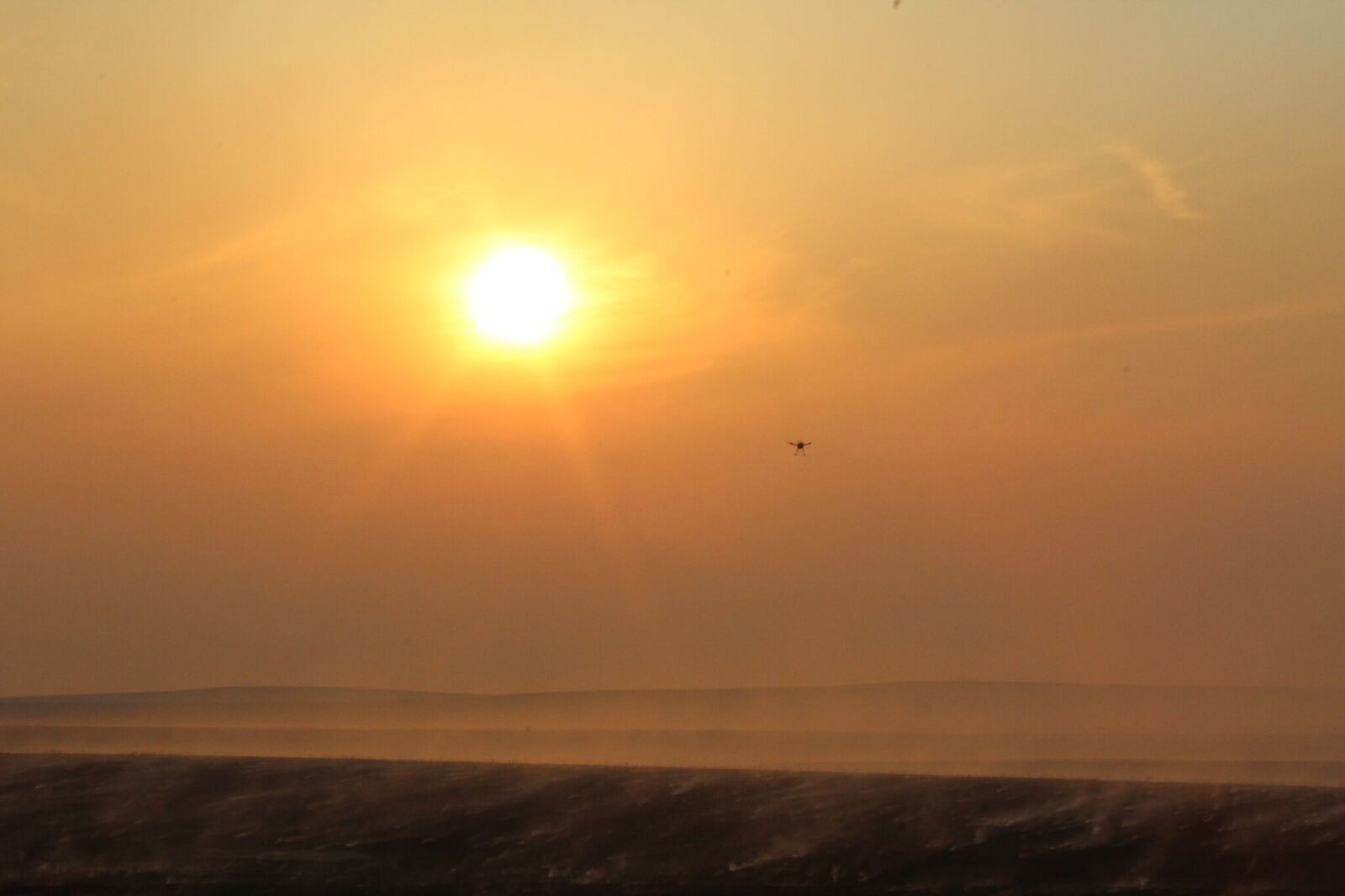
K-State News
Join K-Staters for the second KSUnite
Kansas State University established a precedence with the KSUnite movement last November. While racial tension and unrest were prevalent and creating division on many campuses across the nation, the K-State family chose to unite and reaffirm a university pledge focused on shared values and a dedication to foster an inclusive and welcoming atmosphere in which all can share and learn from one another.These values are the heart and soul of our university, serving as the foundation for K-State's Principles of Community.
Our first KSUnite movement was not just a one-day event. It was followed by numerous discussions, events and trainings on our campuses throughout the year. The event served as a marker for our commitment to diversity and inclusion.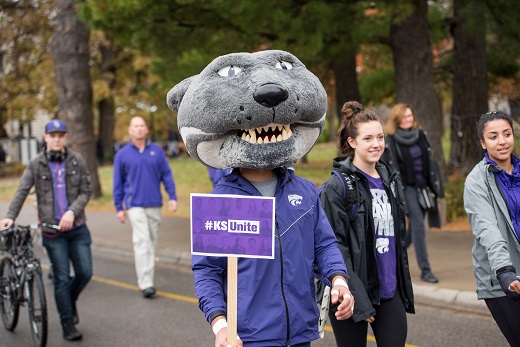 We are ready to mark that commitment once again and invite our university community to participate in the second KSUnite on Tuesday, Oct. 9. A planning committee is finalizing the details, but the day's activities will include facilitated conversations at the Student Union from 10–11:45 a.m. Then from 1–3:30 p.m. our university offices will be closed and classes will be canceled to allow all students, faculty and staff to walk to K-State's World War I Memorial stadium for a program beginning at 1:30 p.m.
We are ready to mark that commitment once again and invite our university community to participate in the second KSUnite on Tuesday, Oct. 9. A planning committee is finalizing the details, but the day's activities will include facilitated conversations at the Student Union from 10–11:45 a.m. Then from 1–3:30 p.m. our university offices will be closed and classes will be canceled to allow all students, faculty and staff to walk to K-State's World War I Memorial stadium for a program beginning at 1:30 p.m.
Bernard Franklin, vice president of Student Life at Mount St. Mary's University in Baltimore, Maryland, will be the keynote speaker. Bernard was the first African-American student body president at K-State from 1975-1976. It's fitting that he returns for Homecoming week to be the keynote speaker at KSUnite. He received a Bachelor of Science degree in political science from K-State in 1976 and a doctorate in education and student counseling in 1996.
Class cancellation from 1–3:30 p.m. Oct. 9 affects the following regular class times: 1:05–2:20 p.m. and 2:30–3:45 p.m. If instances arise where rescheduling in specialized classrooms or laboratory environments is not feasible, or canceling sections of a multi-section course would result in the loss of an entire class week, then the instructor will determine whether classes will be canceled.
We encourage all faculty to integrate diversity and inclusion into their classes throughout the day and to work with students who would like to attend the morning conversations. More detailed information on the facilitated conversations and the program at World War I Memorial Stadium is forthcoming.
For those who cannot physically attend the KSUnite main program, online streaming will be available. Thank you for creating and supporting an environment that values diversity and inclusion, and we look forward to seeing Purple Pride for KSUnite.
Sincerely,
Richard Myers
President
Charles Taber
Provost and Executive Vice President
Bryan Samuel, CCDP/AP
Chief Diversity and Inclusion Officer
Before the fire: Large-scale study aims to improve burning management of Flint Hills
Kansas State University researchers are part of a large collaborative project that is using unmanned aircraft to improve the Kansas Flint Hills Smoke Management Plan.
The three-year project is funded by the Kansas Department of Health and Environment, or KDHE, and involves university scientists; NASA scientists; unmanned aircraft systems pilots from the Kansas State University Polytechnic Campus; meteorologists; ranchers; and environmentalists. The research team members have varied backgrounds, but they all share a common goal: improve the environment and human health while balancing the livelihood of ranchers and farmers.
"We want to have our data be useful for keeping fire as a practice that is both ecologically acceptable and socially acceptable in the Great Plains," said Carol Baldwin, the project leader and a K-State Research and Extension associate in the College of Agriculture.
The team is collaborating with a Flint Hills rancher to gather data during typical tallgrass prescribed burns. The researchers have attached sensors on unmanned aircraft to gather air quality information during a burn.
The information they gather is helping NASA verify satellite data products and is facilitating collaboration between KDHE and the Environmental Protection Agency to improve the Kansas Flint Hills Smoke Management Plan. The plan was implemented in 2011 and helps ranchers make decisions about the best days to burn without negatively affecting human health, particularly in metropolitan areas.
In the past, when the weather conditions were right, Flint Hills spring burning affected air quality in Wichita, Topeka, Kansas City and metropolitan areas in Nebraska and Oklahoma. The poor air quality is bad for people with asthma and other health problems. The challenge is that fire is needed to maintaining the integrity of the tallgrass prairie landscape, Baldwin said.
"We need fire," said Baldwin, who is an expert in grassland range management. "If we take fire and grazing out of the ecosystem, we will not have prairies as we know them. We will end up with a scrubby woodland."
Current smoke management models, such as the Flint Hills plan, use data from fires in other parts of the U.S., not in the Great Plains, Baldwin said, and that's a problem. The university-led project wants to get more accurate fire data from the Great Plains region by working with real ranchers during a typical burn.
"It is our hope that ranchers in the Flint Hills will use these tools to plan their burns so they do not impact air quality downwind from the fire," said Doug Watson, air monitoring and planning chief with the Kansas Department of Health and Environment. "At the same time, we want to educate the metropolitan areas about the importance of the Flint Hills ecosystem and the reasons why the ranchers burn to maintain that ecosystem."
Using unmanned aircraft
To test a prescribed burn, the researchers are working with Jane Koger, a Matfield Green rancher. Koger has allowed the researchers to collect data before, during and after the annual burns on her ranchland.
UAS pilots gather smoke emissions from a controlled burn by flying three unmanned aircraft into the smoke above the fires. The unmanned aircraft use continuous sensors and sample sensors to measure particles and ozone-causing chemicals, and they use thermal imaging to measure fire temperature. The continuous sensors use lasers to take measurements and send data, including particle concentration, ozone levels, temperature and humidity. The sample sensors have a small bag to gather and bring back air particulate samples that are analyzed for particulate matter, or PM, as well as nitrogen dioxide and volatile organic carbon, or VOC, levels.
Travis Balthazor, UAS flight operations manager, is leading the team of 12 trained UAS pilots, which includes researchers and students with the Kansas State University Polytechnic Campus. The students are getting real-world experience through the project, Balthazor said.
"This is outside the realm of our normal box, so this is an effort that benefits us in the long run," Balthazor said. "As far as operating aircraft and looking to the future of unmanned aircraft, everybody wants to fly beyond line of sight and they want to fly higher. We are getting a taste of that with this project."
After the burn
After each burn, the researchers have a record of grass biomass that was burned, the fire's heat levels and the emission levels from the fire.
This data is helping NASA verify satellite imagery and remotely driven emissions estimates. NASA uses imaging from satellite data to determine a fire's intensity and smoke emission rates. To complete validation, researchers combine direct measurements of black carbon production with data from a thermal camera that measures the full range of a fire's internal temperatures. The research also is helping NASA improve satellite data models.
Other project collaborators — including Deon Van Der Merwe, adjunct faculty member in diagnostic medicine and pathobiology in the university's College of Veterinary Medicine — are using the unmanned aircraft to estimate fire size by flying aircraft above grassland before a prescribed burn to determine how much grass, trees or shrubs are in the area.
For rancher Koger, the research project can help ranchers like her learn how to maintain the tallgrass prairie without damaging their livelihoods.
"I think it's important to get a better understanding of what we are doing and what we are putting into the air," Koger said. "We have kids and grandkids, and some of them have asthma. It does affect all of us. When we have concrete science — and when K-State shares that — ranchers listen. Getting some numbers and knowing what we are really doing and getting that back out to the public will speak to people."
Collaborators
The full list of Kansas State University collaborators:
Carol Baldwin, K-State Research and Extension range management associate in the College of Agriculture; Travis Balthazor, UAS flight operations manager, David Burchfield, teaching assistant professor of unmanned aircraft systems, and Kurt Carraway, UAS research executive director, all with Kansas State University Polytechnic Campus; Zifei Liu, assistant professor of biological and agricultural engineering in the College of Engineering; Randall Mai, research technologist in agronomy and weather station technician with Kansas Mesonet; Christopher Redmond, assistant scientist in agronomy and network manager with Kansas Mesonet; and Deon Van Der Merwe, adjunct faculty member in diagnostic medicine and pathobiology in the College of Veterinary Medicine and Utrecht University faculty member.
Other collaborators:
Jane Koger, a commercial rancher from Matfield Green; Jayson Prentice, technical resources and projects unit supervisor, Kathleen Waters, environmental program administrative supervisor, and Doug Watson, air monitoring and planning chief, all with the Kansas Department of Health and Environment; Charles Ichoku, research physical scientist with the Climate and Radiation Laboratory at NASA Goddard Space Flight Center; Luke Ellison, scientist with Science Systems and Applications Inc. at NASA Goddard Space Flight Center; and David Bush, senior scientist with Technical and Business Systems Inc., a California-based company that developed the unmanned aircraft sensors.
In great SHAPE: Kansas State University Polytechnic Campus earns honor from Kansas Department of Labor for workplace safety
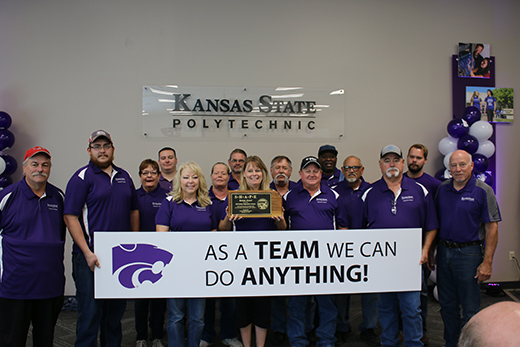 Kansas State University Polytechnic Campus is a recipient of the Kansas Department of Labor's Safety and Health Award for Public Employees, known as SHAPE.
Kansas State University Polytechnic Campus is a recipient of the Kansas Department of Labor's Safety and Health Award for Public Employees, known as SHAPE.
The state department developed the SHAPE program to promote safety in the workplace and recognize safety-conscience employers and employees in the public sector.
Kansas State Polytechnic's facilities department has been actively pursuing a robust safety culture on campus by empowering all employees to take part in successful safety measures around campus. This includes implementing a well-managed safety and health program that saves lives, increases quality of life, improves morale and productivity, and decreases both direct and indirect costs.
"I am very proud of the dedication our facilities staff members have demonstrated over the last two years in improving the safety of campus operations," said Alysia Starkey, interim dean and CEO. "Their commitment and concern for ensuring Kansas State Polytechnic maintains a healthy work and living environment for our students, faculty and staff is commendable. The facilities team will lead the effort as we continue to expand their safety program to other campus units."
To receive SHAPE recognition, program participants must meet a rigorous set of standards that includes a comprehensive safety inspection from the Kansas Department of Labor and then correcting all noted hazards; establishing effective health and safety training programs; maintaining accurate injury and illness records according to the Occupational Safety and Health Administration standards; meeting the minimum requirements for qualifying Kansas level of injury and illness rates; and actively involve employees in workplace safety and health programs.
"Achieving the SHAPE award illustrates teamwork at Kansas State Polytechnic between the employer and employees in working together to provide a safe work environment," said Lana Gordon, Kansas secretary of labor. "This kind of attention to safety allows for less days lost on the job and for workers to return home free from injury. The Kansas Department of Labor's industrial safety and health consultants provide free consultation services to help businesses prevent hazards at work. We are pleased to partner with Kansas State Polytechnic to help it achieve the SHAPE designation."
Kansas State Polytechnic was recognized in a ceremony on campus Sept. 11. For more information on Kansas State Polytechnic's health and safety programs, contact Rene Leiker at 785-826-2911.
K-State Faculty Highlight
De Noble and Rolley selected as Most Admired Educators
Tim de Noble, professor and dean of the College of Architecture, Planning & Design, or APDesgn, and Stephanie Rolley,professor and department head of landscape architecture and regional & community planning, have again been selected and recognized by DesignIntelligence as among the Top 25 Most Admired Educators in Architecture, Interiors, and Landscape Architecture for 2019.
As stated by DesignIntelligence, "Each year for the past 19 years, DesignIntelligence has conducted the same survey across the design industry regarding architecture school rankings. The number of valid responses from hiring managers of architecture and design-professional firms typically range between 2,600 and 3,200, year over year. But this year was markedly different: with more than 4,500 valid responses, which may reflect the urgency of improving architectural education."
"The college is exceptionally blessed to have two multiyear DesignIntelligence award winners," said Victor Regnier, distinguished professor and associate dean of research at the University of Southern California School of Architecture. "These are based on the outstanding reputations of faculty and the full spectrum of design programs housed in APDesign. To have a dean and department chair receive this award also is clear testament to the high regard APDesign has toward teaching quality and general excellence."
De Noble has served as dean of the College of Architecture, Planning & Design since 2009. Before arriving at K-State, de Noble served as head of the Department of Architecture at the Fay Jones School of Architecture at the University of Arkansas and previously taught at Syracuse University. 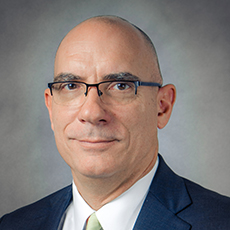 In addition to teaching studio and technology courses, de Noble has extensive teaching experience in Italy and Mexico.
In addition to teaching studio and technology courses, de Noble has extensive teaching experience in Italy and Mexico.
He was recently named an "Icon of Education" by Ingram's magazine, received the chapter artist award from the K-State chapter of Phi Kappa Phi Honor Society, was cited as one of the 25 Most Admired Educators for 2016-17 by DesignIntelligence, and was named 2016 Architecture Advocate of the Year by the American Institute of Architects Kansas City Chapter. He is a member of the American Institute of Architects.
De Noble received a Master of Architecture from Syracuse University and a Bachelor of Science in architecture from the University of Texas at Arlington. In private practice throughout his teaching career, he founded deMX Architecture in Fayetteville, Arkansas, in 1999, building an award-winning practice focusing on housing combining the socially liberating potency of modernism with the intuitive rationality of vernacular building to generate regionally specific responses to built-form and site. Outside of practice, his primary research interest focuses on the typologies and morphologies of towns and cities.
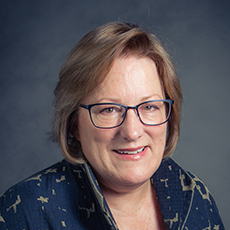 Rolley joined the university in 1987 as an assistant professor of landscape architecture, becoming a full professor in 2003 and department head in 2009. She also led the development of the department's nonbaccalaureate master's degree tracks in landscape architecture and regional and community planning, which are among the best in the nation. Rolley also has shaped K-State's role in the innovative online Master of Science in Community Development offered by the Great Plains IDEA consortium.
Rolley joined the university in 1987 as an assistant professor of landscape architecture, becoming a full professor in 2003 and department head in 2009. She also led the development of the department's nonbaccalaureate master's degree tracks in landscape architecture and regional and community planning, which are among the best in the nation. Rolley also has shaped K-State's role in the innovative online Master of Science in Community Development offered by the Great Plains IDEA consortium.
Rolley's commitment to enhancing professional planning and design education includes service on the Landscape Architecture Magazine Editorial Committee and leadership of the American Society of Landscape Architecture Council on Education and the Landscape Architecture Accreditation Board. She received the national American Society of Landscape Architecture's Outstanding Service Award in 2015. Rolley is a fellow of the American Society of Landscape Architecture, American Institute of Certified Planners and of the Council of Educators of Landscape Architecture. She has been honored with the K-State Presidential Award for Outstanding Department Head and the Council of Educators of Landscape Architecture's Outstanding Administrator Award. Named one of the 25 Most Admired Educators for 2016-17 by DesignIntelligence, she currently serves as president-elect of the Landscape Architecture Foundation board of directors.
Rolley earned a Bachelor of Landscape Architecture from K-State and a master's degree in city planning from the Massachusetts Institute of Technology. She also completed the Management Development Program offered through Harvard University's Graduate School of Education.
K-State Student News
Carlson named to national Kappa Omicron Nu board of directors
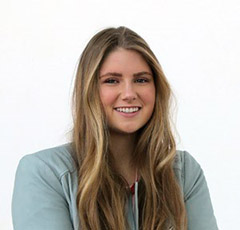 Brynn Carlson, sophomore in dietetics, Woodbury, Minnesota, was named to the Kappa Omicron Nu national board of directors as a student member for a two-year term beginning this year.
Brynn Carlson, sophomore in dietetics, Woodbury, Minnesota, was named to the Kappa Omicron Nu national board of directors as a student member for a two-year term beginning this year.
Kappa Omicron Nu is the leading honor society for students in the human sciences. The mission of the honor society is to empower leaders who use an integrative approach to enhance the quality of living through excellence in scholarship, leadership and research. Kappa Omicron Nu values recognition, reward, advancement and strong affiliation networks.
Carlson has chosen to study dietetics because of her love for serving others and her desire to assist people in becoming the best versions of themselves.
"As a volleyball student-athlete at K-State, I have a plethora of personal experience working with nutrition and performance and I want to be able to expand on that knowledge and bring it to others," she said. "Kappa Omicron Nu is an organization that is committed to serving its students through access to a variety of scholarships and internships, as well as vast networking opportunities. I desire to make an impact on Kappa Omicron Nu because I think it is an important organization that gives valuable opportunities to students, and as a voting member, I would be giving a voice to the students within the leadership of Kappa Omicron Nu."
Following her time at K-State, Carlson will pursue a career as a sports dietitian so that she can work with athletes and help them maximize their potential.